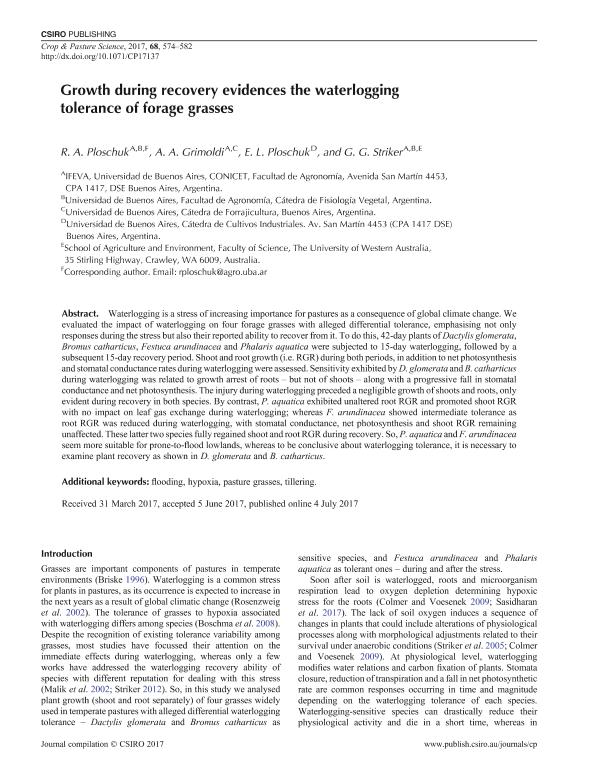Artículo
Growth during recovery evidences the waterlogging tolerance of forage grasses
Ploschuk, Rocio Antonella ; Grimoldi, Agustin Alberto
; Grimoldi, Agustin Alberto ; Ploschuk, Edmundo Leonardo; Striker, Gustavo Gabriel
; Ploschuk, Edmundo Leonardo; Striker, Gustavo Gabriel
 ; Grimoldi, Agustin Alberto
; Grimoldi, Agustin Alberto ; Ploschuk, Edmundo Leonardo; Striker, Gustavo Gabriel
; Ploschuk, Edmundo Leonardo; Striker, Gustavo Gabriel
Fecha de publicación:
07/2017
Editorial:
CSIRO
Revista:
Crop and Pasture Science
ISSN:
1836-0947
e-ISSN:
1836-5795
Idioma:
Inglés
Tipo de recurso:
Artículo publicado
Clasificación temática:
Resumen
Waterlogging is a stress of increasing importance for pastures as a consequence of global climate change. We evaluated the impact of waterlogging on four forage grasses with alleged differential tolerance, emphasising not only responses during the stress but also their reported ability to recover from it. To do this, 42-day plants of Dactylis glomerata, Bromus catharticus, Festuca arundinacea and Phalaris aquatica were subjected to 15-day waterlogging, followed by a subsequent 15-day recovery period. Shoot and root growth (i.e. RGR) during both periods, in addition to net photosynthesis and stomatal conductance rates during waterlogging were assessed. Sensitivity exhibited by D. glomerata and B. catharticus during waterlogging was related to growth arrest of roots - but not of shoots - along with a progressive fall in stomatal conductance and net photosynthesis. The injury during waterlogging preceded a negligible growth of shoots and roots, only evident during recovery in both species. By contrast, P. aquatica exhibited unaltered root RGR and promoted shoot RGR with no impact on leaf gas exchange during waterlogging; whereas F. arundinacea showed intermediate tolerance as root RGR was reduced during waterlogging, with stomatal conductance, net photosynthesis and shoot RGR remaining unaffected. These latter two species fully regained shoot and root RGR during recovery. So, P. aquatica and F. arundinacea seem more suitable for prone-to-flood lowlands, whereas to be conclusive about waterlogging tolerance, it is necessary to examine plant recovery as shown in D. glomerata and B. catharticus.
Palabras clave:
Flooding
,
Hypoxia
,
Pasture Grasses
,
Tillering
Archivos asociados
Licencia
Identificadores
Colecciones
Articulos(IFEVA)
Articulos de INST.D/INV.FISIOLOGICAS Y ECO.VINCULADAS A L/AGRIC
Articulos de INST.D/INV.FISIOLOGICAS Y ECO.VINCULADAS A L/AGRIC
Citación
Ploschuk, Rocio Antonella; Grimoldi, Agustin Alberto; Ploschuk, Edmundo Leonardo; Striker, Gustavo Gabriel; Growth during recovery evidences the waterlogging tolerance of forage grasses; CSIRO; Crop and Pasture Science; 68; 6; 7-2017; 574-582
Compartir
Altmétricas



